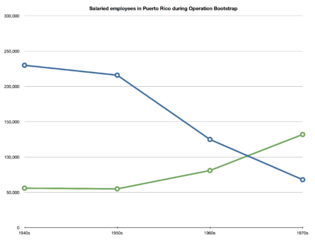History
The island's traditional economy was based around sugarcane plantations. By the middle of the twentieth century it remained one of the poorest in the Caribbean. In 1947 newly elected Puerto Rican governor Luis Muñoz Marín of the Popular Democratic Party along with the United States government began Operation Bootstrap, which invested millions of dollars into Puerto Rico to industrialize the island's economy.[2] Based on 1930s New Deal economic relief reforms and infrastructure provided by the programs such as the Puerto Rico Reconstruction Administration, Operation Bootstrap intended to move Puerto Rico away from its agrarian system and into an industrial economy. The government's Administration of Economic Development — today known as the Puerto Rico Industrial Development Company (PRIDCO) — encouraged the establishment of factories.
The US government in Puerto Rico enticed US companies by providing labor at costs below those on the mainland, access to contiguous US markets without import duties, and profits that could transfer to the mainland free from federal taxation. The Administration of Economic Development invited investment of external capital, importing the raw materials, and exporting the finished products to the mainland. To entice participation, tax exemptions and differential rental rates were offered for industrial facilities. As a result, Puerto Rico's economy shifted labor from agriculture to manufacturing and tourism. The manufacturing sector has shifted from the original labor-intensive industries, such as the manufacturing of food, tobacco, leather, and apparel products, to more capital-intensive industries, such as pharmaceuticals, chemicals, machinery, and electronics.[3] Through this project, a rural agricultural society was transformed into an industrial working class.[4]
Although initially touted as an economic miracle, by the 1960s, Operation Bootstrap was increasingly hampered by a growing unemployment problem.[5] As living standards and wages in Puerto Rico rose, manpower-intensive industries faced competition from outside the United States. It also faced criticism from civil rights groups and the Catholic Church, who perceived the government promoting birth control, encouraging surgical sterilization, even though it was American industrialists concerned with "overpopulation" and a perceived lack of self-control on the part of the working class Puerto Ricans who were driving the widespread birth control programs, not the US Government.[6]
As of 2005 the continental United States remains Puerto Rico's major trading partner, received 86% of Puerto Rico's exports and providing 69% of its imports.[7]
Effects
Salaried employees in Puerto Rico during Operation Bootstrap
| Decade |
Jobs in fishing & agriculture |
Decade-over-decade ratio |
Jobs in manufacturing |
Decade-over-decade ratio |
Employment net loss[lower-alpha 2] |
Employment net loss ratio |
| 1940s |
 | 230,000 |
|
 | N/A |
|
 | 56,000 |
|
 | N/A |
|
 | N/A |
|
 | N/A |
|
| 1950s |
 | 216,000 |
|
 | 6.08% |
|
 | 55,000 |
|
 | 1.79% |
|
 | 15,000 |
|
 | 5.24% |
|
| 1960s |
 | 125,000 |
|
 | 42.13% |
|
 | 81,000 |
|
 | 47.27% |
|
 | 65,000 |
|
 | 23.99% |
|
| 1970s |
 | 68,000 |
|
 | 45.60% |
|
 | 132,000 |
|
 | 62.96% |
|
 | 6,000 |
|
 | 2.91% |
|
| Total |
 | 162,000 |
|
 | 70.43% |
|
 | 76,000 |
|
 | 135.71% |
|
 | 86,000 |
|
 | 30.07% |
|

Chart demonstrating how the
economy of Puerto Rico shifted from
agriculture to
manufacturing by showing how the salaried employees during Operation Bootstrap significantly increased manufacturing jobs (green line) while decreasing agricultural jobs (blue line).
Further reading
- Teodoro Moscoso and Puerto Rico's Operation Bootstrap by A.W. Maldonado. Gainesville: University Press of Florida, 1997.
ISBN 0-8130-1501-4
- Las campañas de control de la natalidad contra las mujeres, by Gloria Arimón en Servir al pueblo, número 233, 1984.
- Economic History of Puerto Rico: Institutional Change and Capitalist Development, by James L. Dietz. Princeton, NJ: Princeton University Press, 1986.
- The Disenchanted Island: Puerto Rico and the United States in the Twentieth Century, by Ronald Fernández. 2ª ed. Westport CT: Praeger, 1996.
- Factories and Food Stamps: The Puerto Rico Model of Development, by Richard Weisskoff. Baltimore, MD: Johns Hopkins University Press, 1985.
Notes
- ↑ FPH (in Spanish) "[...] nuestro actual modelo económico continúa fundamentado en los principios establecidos por Operación Manos a la Obra."[1]
- ↑ While the total sum of employment in fishing, agriculture, and manufacturing did experience a net loss, the industrialization process created jobs in other sectors. The net loss portrayed in this table only takes into account direct jobs associated within these industries without taking into account the indirect jobs associated with them such as those in the service industry and government. The financial sector grew from 10% of GNP in 1950 to 14.4% in 1980, and the governmental sector grew from 10% in 1950 to 17.1% in 1980.[5] Regardless of all this, Puerto Rico did experience an overall net loss due to Bootstrap. The data show that the new economic model generated growth but no employment. New jobs created in manufacturing did not fully compensate for jobs lost in agriculture.[8]
